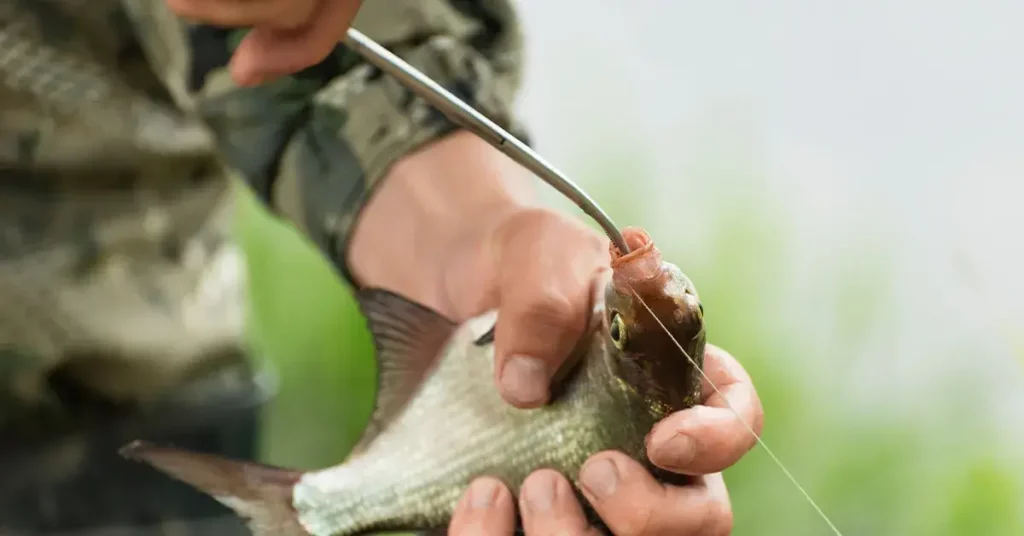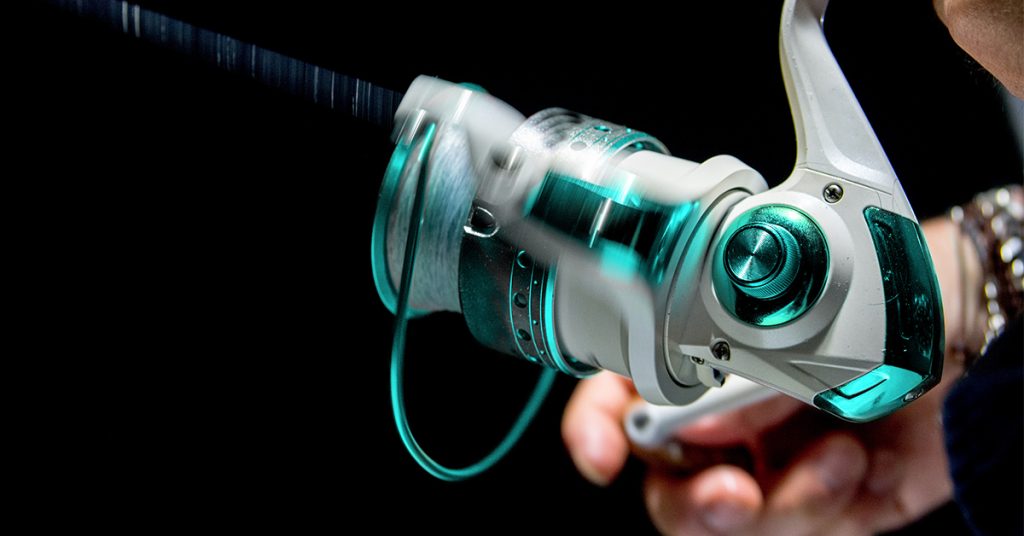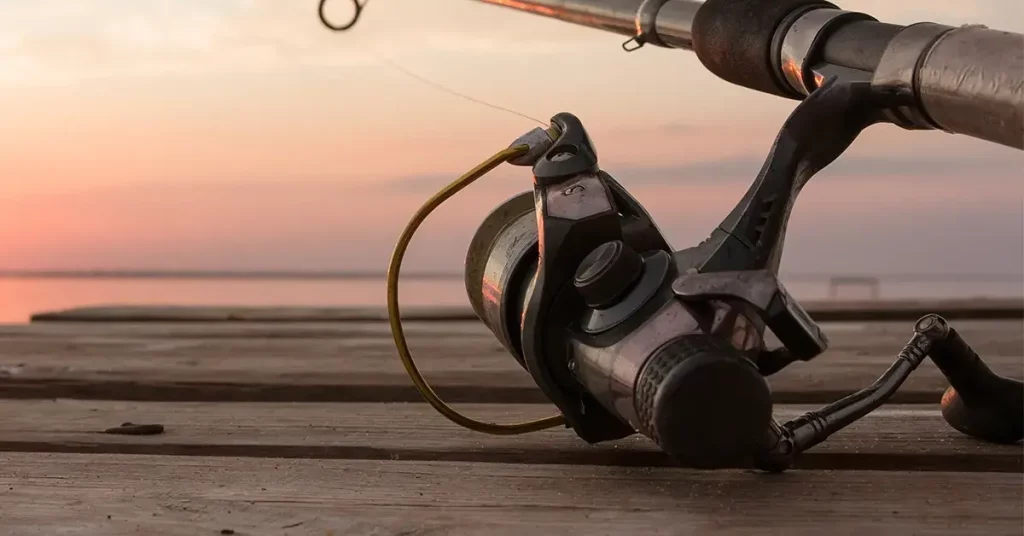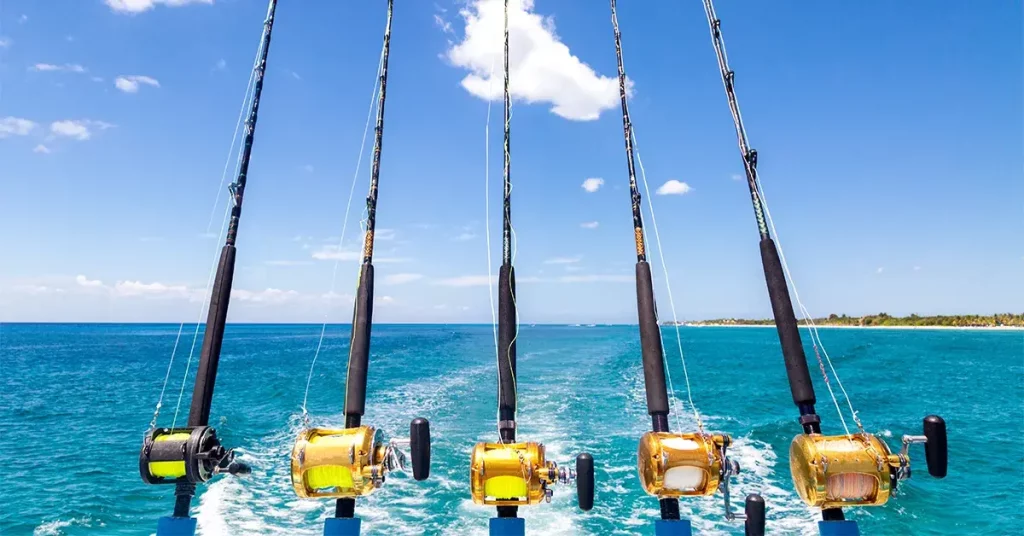Extracting a deeply embedded treble hook from a toothy critter can be a major pain in the rear. If you’ve ever had to reach inside the mouth of an angry Muskie or Bluefish, then you’ll know how essential a good fish hook remover can be.
If you’re a catch and release angler, then a fish hook remover will allow you to quickly and safely extract deeply buried fishhooks without harming the fish – giving it a better chance at survival.
Most fish hook removers are also fairly lightweight and compact, making them more convenient than lugging around a pair of steel pliers.
Quick Answer: 5 Best Fish Hook Removers
- Best Overall: Cuda Dehooker 8 1/2 Inch
- Runner Up: CrazyShark Hook Remover 9.6
- Stainless Steel Hook Remover: Berkley Steel Hook Remover
- Budget Pick: Booms Fishing R2 Hook Remover
- Also Consider: Bubba 12″ Hook Extractor
Why do you need a fish hook remover

Beyond making hook removal easier, a good fish hook remover will prevent cuts and punctures to your fingertips. Reaching into a toothy fish’s mouth can result in some nasty injuries – which can keep you out of the game for some time.
A gut hooked lure can be tough to remove without the assistance of a hook remover. The added length allows you to reach deep inside the fish’s mouth without harming yourself or the fish. It also means you’ll lose less of your favorite tackle, saving you some hard earned cash.
Spring loaded hook removers allow you to operate them single-handed, which makes one-handed hook removal a breeze.
Best Overall: Cuda Dehooker 8 1/2 Inch
This durable and comfortable titanium bonded hook remover from Cuda is a perfect choice when you need to extract a deeply buried fishhook. Cuda makes some of the best fishing accessories on the market and this dehooker is no exception. The T-shaped handles feature Cuda’s “Cuda Scale” pattern grips – providing an incredibly secure and comfortable grip no matter how slippery the conditions get.
Unlike most other hook removers, the dehooking mechanism is made from titanium rather than stainless steel. This makes it tougher and more corrosion resistant – which is ideal for use around saltwater. The patented titanium bonded process makes it three times as tough as untreated steel.
The 8.5” shaft is made from an aluminum alloy, making it lightweight and corrosion-resistant. Its length is ideal for most freshwater and smaller saltwater fish. If you’re looking for a pair to tackle larger saltwater species, Cuda also makes an identical 18” long model available here.]
Key Features
- Length: 8.5”
- Titanium bonded hook mechanism is tough and corrosion resistant
- Grips feature ‘Cuda scale pattern’ dual grips
- Lifetime manufacturer warranty
- Fishing Hook Remover: The ultimate fishing tool, this specialized piece of fishing gear and equipment is engineered for safe and easy hook removal
- Durable Construction: Constructed from corrosion-resistant aluminum alloy, our dehooker features a titanium-bonded dehooking mechanism that will not flake, blister, chip, or peel
- Non-Slip Grip: Great for freshwater or small salt species, our dehooker comes equipped with dual Cuda Scale Pattern grips for a comfortable and incredibly secure grip in all conditions
- Easy To Use: Insert into fish’s mouth, wrap the dehooking mechanism around the hook, pull the handle, and the mechanism will grab the hook; Remove tool from fish and release the handle to open the dehooking mechanism
- Easy to use - insert tool into fish mouth, wrap dehooking mechanism around the hook, pull the handle and the mechanism will grab the hook, remove tool from fish then release the handle to open the dehooking mechanism
- Titanium bonded dehooking mechanism
- Corrosion resistant
- Aluminum construction
- Non-slip Cuda scale pattern grips
- Lifetime Warranty
View Pricing On:
Runner Up: CrazyShark Hook Remover 9.6
This lightweight aircraft-grade aluminum hook remover is both tough and versatile. Its 9.6 inch length allows you to reach deep inside a gut-hooked fish without injuring yourself or the fish. The stainless steel hook is tough and corrosion-resistant, which makes extracting any sized hook a breeze.
The pistol grips and internal spring make it easy to use single-handed, so you can quickly and easily pull out a hook without harming the fish’s jaw or slime coat. Ergonomic ABS plastic handles give you a comfortable non-slip grip, making it comfortable to use for prolonged periods of time.
The 9.6 inch length makes it ideal for larger species like Muskie, Pike, and Bass. There’s also a 13.6 inch version available, for those who prefer an even longer shaft length.
A tether hole is drilled into the butt-end, making it easy to lash to your vest or waders.
Key Features
- Length: 9.6”
- Weight: 4.6 Ounces
- Durable stainless steel jaws
- Aircraft-grade aluminum body is lightweight and corrosion-resistant
- √ Light weight &Strong: Selected aviation class aluminum tube with Stainless steel hook
- √ Comfortable handling: Ergonomic Carbine design
- √ Fashion colors: Corrosion resistant fashion attractive colors
- √ Easy Operation: Simply 3 steps to do hook out, fix the hook, release from the fish and take the hook
Prices pulled from the Amazon Product Advertising API on:
Product prices and availability are accurate as of the date/time indicated and are subject to change. Any price and availability information displayed on [relevant Amazon Site(s), as applicable] at the time of purchase will apply to the purchase of this product.
Stainless Steel Hook Remover: Berkley Steel Hook Remover
This burly and substantial hook remover is ideal for extracting hooks from salmon, halibut, pike or any larger fish species. It’s built like a tank, and as long as you give it a quick freshwater rinse and wipe after use in saltwater, it should last for many years.
The design is slightly different than other fish hook removers, with a pincher-style jaw that’s activated by compressing the spring-loaded trigger handles. This makes it highly versatile and capable of a variety of other tasks like gardening, picking up nails, and extracting wires deeply embedded in a wall socket.
The grabber end features serrated gripping surfaces, which helps to lock a fishhook in place as you extract it. The entire tool measures 11 inches from tip to tail, making it perfect for reaching deep into a big fish’s mouth.
Key Features
- Length: 11”
- Durable stainless steel construction – can take a beating
- Price is reasonable
- A great addition to any tackle box – particularly if you target larger species
- Sure-grip jaw action
- Removes embedded hooks safely
- Spring-loaded trigger handle
- Extracts with Minimal harm to your catch
Prices pulled from the Amazon Product Advertising API on:
Product prices and availability are accurate as of the date/time indicated and are subject to change. Any price and availability information displayed on [relevant Amazon Site(s), as applicable] at the time of purchase will apply to the purchase of this product.
Budget Pick: Booms Fishing R2 Hook Remover
Lightweight and ergonomic, these hook removers get the job done and don’t cost an arm and a leg. The T-shaped plastic grips feel solid and are easy to operate single-handed. Constructed from anodized aluminum, the tube is lightweight and corrosion-resistant – making it perfect for saltwater usage.
The tool measures 10” long, which is a nice mid-sized length suitable for a variety of fish sizes and species. An adjustable wrist lanyard also comes included, allowing you to keep it from falling in the water and sinking.
The stainless steel hook removal mechanism is both tough and corrosion-resistant, ensuring it can function in the saltwater environment.
Key Features
- Length: 10”
- T-style ergonomic grips are easy to use single handed
- Anodized aluminum shaft and stainless steel hook are saltwater resistant
- Comes with an adjustable wrist lanyard
- (Single Hand Operation) The ergonomic plastic handle can fit your palm perfectly. Nice for twisting wrist and single hand use
- (Remove Hooks Swallowed Deeply) Getting those troublesome hooks out , such as gut hook
- (More Protection) Dont worry about those fish with sharp teeth, such as trout and snapper etc, the hook remover will keep your fingers away from hooks
- (Less Harm) Remove most of hooks even the deep embedded hooks with less harm to the fish that allows angler to release fish to water
- Anodized Aluminum has a good corrosion resistance to salt water, the ergonomics plastic handle provides comfortable and natural grip
Prices pulled from the Amazon Product Advertising API on:
Product prices and availability are accurate as of the date/time indicated and are subject to change. Any price and availability information displayed on [relevant Amazon Site(s), as applicable] at the time of purchase will apply to the purchase of this product.
Also Consider: Bubba 12″ Hook Extractor
If you’re looking for a well-made hook remover with enough reach to get deep down and extract gut hooked fish, this is the one for you. It features a 12″ long anodized aluminum shaft and is 16.5″ long including the handle. This gives you enough reach to get down into a large toothy pike or snapper.
The hard anodized aluminum shaft is coated in titanium nitride making it tough and corrosion-resistant, and suitable for both freshwater and saltwater fishing. Non-slip, scaled, ergonomic plastic handles provide a sturdy and comfortable grip.
The stainless steel hook remover end doubles as a line cutter – so you can slice through mono, braid, and fluorocarbon line in a pinch.
Key Features
- Length: 12″ shaft
- Stainless steel hook doubles as line cutter
- Ergonomic, non-slip, scaled grips are comfortable for prolonged use
- Titanium-coated anodized aluminum shaft works for both freshwater and saltwater fishing
- DIMENSIONS: 16.5 Overall Length; 4. 5 Handle and 12 Aluminum Hook Extractor
- DURABLE: Constructed of Anodized Aluminum with Stainless Steel Interior for Ultimate Strength
- RELIABLE: Can cut through mono, braid or fluorocarbon line with marine grade stainless steel hook extractor
- CONVENIENT: Removes hooks faster, safe and do less harm to the fish, while protecting your hands
- EASE OF USE: T Handle Style Non Slip Grip handle for outstanding grip security providing ultimate control and ergonomically designed for comfort
Prices pulled from the Amazon Product Advertising API on:
Product prices and availability are accurate as of the date/time indicated and are subject to change. Any price and availability information displayed on [relevant Amazon Site(s), as applicable] at the time of purchase will apply to the purchase of this product.
How to pick the right fish hook remover
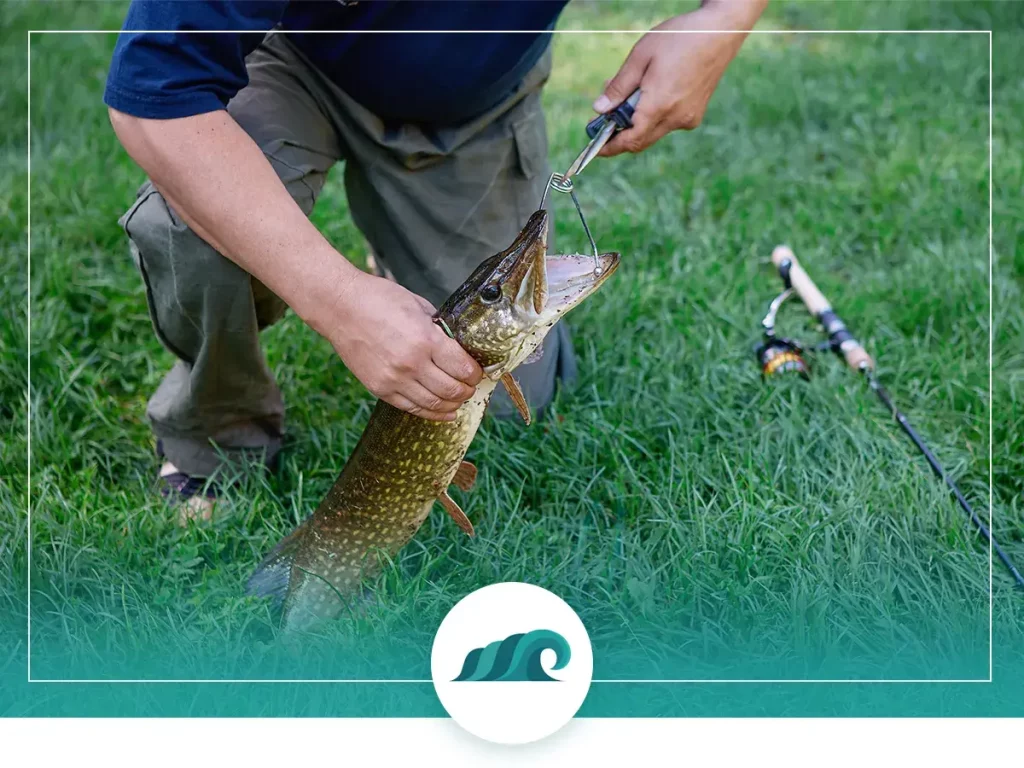
Picking the right fish hook remover will depend on the fish species you’re targeting, the hook size you’re using, as well as the environment. Let’s take a look at some of the key features to consider when picking the best fish hook remover for you.
Shaft Length
Hook removers come in a variety of lengths, from shorter 8” models to lengthy 13”+ ones.
Obviously shorter models are going to be better suited to smaller freshwater species such as bass, walleye, and trout. Longer models excel at reaching deep inside a fish’s mouth and extracting deeply hooked lures. These are ideal for larger freshwater species like northern pike, muskie, bowfin as well as saltwater fish like halibut, barracuda, wahoo, and bluefish.
One thing to consider is that hook removers with longer shafts can be awkward to use on smaller fish species. The added length can be unwieldy, making hook removal more difficult. If you frequently fish both large and small species, then getting a separate dehooker for each is a smart move.
Material
Most hook removers are made from either anodized aluminum or stainless steel.
Anodized aluminum is lightweight, corrosion-resistant and fairly robust. It can be used around saltwater without worry about corrosion or rust. It’s not the toughest material though, so don’t plan on using one of these as a makeshift prybar.
Stainless steel is tough, substantial, but not totally corrosion-proof. Stainless steel hook removers can be thrown around the boat and abused and will still last for years. Don’t forget to give them a quick freshwater rinse after use to prevent corrosion from forming.
The hook removal mechanism itself is typically made out of stainless steel, but titanium models are also available. The major advantage of titanium is that it’s totally corrosion-proof, but it costs a bit more.
Hook Size
Most hook removers are best suited for removing medium to large sized hooks (#6 and up). Because the spring mechanism is fairly robust, it can be too strong for smaller hooks and can cause them to break. If you’re looking for a tool to extract small hooks (#8 and smaller), then a pair of fishing pliers would work well.
Grip
Fish hook removers typically utilize either a T-style grip or a pistol-grip. Both grips are highly effective and can be used single-handed. The choice really comes down to your personal preference.
T-style grips are a bit more compact that pistol grips, so will take up less space in your tackle box. Some anglers believe pistol-grips provide a higher level of precision, but again it really comes down to your personal preferences.
Spring Loaded vs. Solid Piece
Newer hook removers tend to utilize an internal spring to activate the hook removal mechanism, making one-handed operation easy. Older models used a long metal rod with a curved hook at the end, which meant you had to manually pry the hook out. All the models reviewed here are the internal spring-loaded style, as they’re more versatile and easy to use.
Extras
Some hook removers come with extra features that can come in handy depending on your situation. Built-in flashlights can be particularly useful for nighttime fishing or any other low-light scenarios. Many hook removers come with some kind of lanyard, allowing you to easily lash them to a life vest or waders.
FAQ’s:
How to use a fish hook remover?
To remove a fishhook from a fish’s mouth or lip, simply hook the end of the hook remover mechanism as close to the fish’s body as possible. Then depress the grips in order to clasp the hook and twist it out the same way it came in.
Depending on where the fish is hooked, you may need to flatten out the barb to get the hook to slide out easily. Keep in mind that barbless hooks are much easier to remove than barbed ones.
If a fish is gut hooked and you’re unable to get to the hook, then cutting the hook or line as close to the fish’s body as possible is the best option. This will allow the fish to eventually spit out the hook, minimizing the chance of serious injury and death.
A good pair of fish grippers can come in handy when you’re trying to hold a fish still and remove a hook. Fish scales are also useful if you want to get an accurate weight measurement of your catch.
How to remove a fish hook from skin?
If you’re unlucky enough to get a fish hook buried in your finger, hand, arm or face (ouch!), you’ll need to remove it promptly to avoid pain and infection. Check out my detailed guide to removing a fish hook from your skin for a step by step tutorial.

